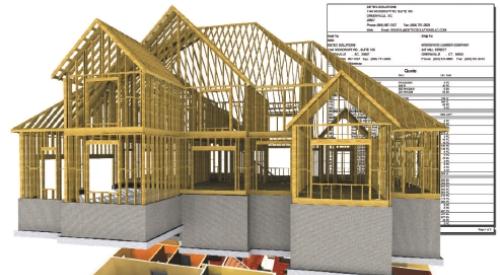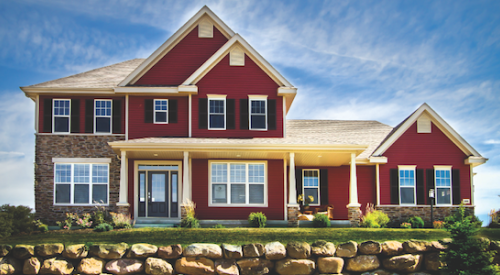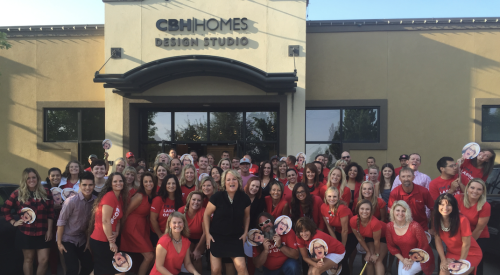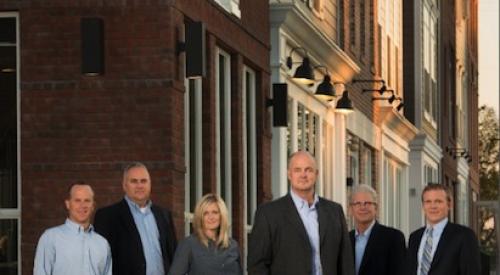To David Simon, president of operations and co-founder of Veridian Homes, the secret to building better homes and communities starts with a better building team.
Led by Simon and partner Jeff Rosenberg, president of land development and acquisition, the Madison, Wis.-based firm focuses on traditional community development based on smart growth principles and green building practices. But what really makes Veridian Homes — Professional Builder's Builder of the Year for 2008 — a vanguard for the industry is the extent to which the company empowers its building team members to affect the process.
Company management does not just invite participation and feedback from employees, trade partners, and even home buyers to some degree. The team insists on it. It backs that up by constantly seeking out the latest in best practice and quality improvement methodologies more often associated with today's most successful business leaders outside the home building industry and adapting them for their own employees to use.
This approach has made the four-year-old company a winner, both in profitability and industry accolades. What also make Veridian Homes unique are the company's programs to continuously reevaluate the efficiency of its building processes; its rigorous attention to quality improvement; insistence on top-notch employee and trade partner ethics; and steadfast dedication to reducing the impact that its operations have on the environment.
Today, Veridian Homes is the largest residential builder in the state of Wisconsin, constructing nearly 500 single-family and attached homes and condominiums a year ranging in price from $170,000 to $700,000, earning it a market share of over 30 percent. Every year, the company measures itself against all NAHB-sponsored Builder 20 groups nationwide and has remained in the top 25 percent in terms of profitability since it was founded. The company predicts profits to be $121 million in 2007 and $136 million in 2008. These are impressive figures, particularly in light of the economic uncertainty presented by today's housing market.
"Sure, this market is a tough one," says Simon, "But we will weather it, and it will rebound. What has really helped us is that we already have established extremely strong brand recognition with our buyers for quality and customer service. This is not a panacea, but it helps. You have to constantly reevaluate things to make sure that you are meeting your customers' needs. At the same time, you have to make sure that you are priced appropriately."
Veridian Homes maintains a portfolio of more than 40 plans, including single-family, twin-home (the company's term for duplex plans), townhome and condominium designs, and offers buyers virtually unlimited options for customizing them. This flexibility in price, style and product line allows the builder to appeal to a broad spectrum of buyers ranging from first timers to empty nesters. They also have a series of home plans designed for more upscale buyers.
"We recognize that it takes a lot of effort on their part for people to move," says Simon, "and the reality is that they are just not that willing to do it. We do everything we can so that the process is hassle-free for them."
The company makes a wide range of financing options and incentives available to buyers to simplify the purchase process, including a 0% down payment program, another that guarantees the sale of the buyer's existing home, rent liberation programs, and a program that rewards repeat buyers with a discount on the purchase price of a new home when they buy from the builder again.
"Our mission is to build great homes and great communities," says Simon. Company employees are guided by the principle that "under-promising and over-delivering" is the best way to have a satisfied customer in the end.
Relishing the Role as a Leader
"We may not be a large national builder," says Simon, "but we are a big one in Madison, Wis. Even so, we look at our vision as one customer at a time, one home at a time. Our goal is to make each customer feel as though they are the most important person in our lives when we work with them."
Translating that sentiment into practical application takes a keen awareness of today's buyer markets and a willingness to roll with the changes.
"First and foremost home builders have to recognize that our business is all about how we can fulfill our customers' dreams — how we can enrich their lives through the homes we build for them," says Simon, "But it is just as important to realize that every year consumer's expectations are going up. To be successful we have to be constantly reinventing ourselves to meet those evolving expectations and to keep pushing the bar in terms of satisfaction and of quality.
"Our industry must continue to move forward, and I think that we were one of the last to get that message. On the whole, we have been slow to adapt to the changes in the marketplace. There exists the constant challenge to move beyond the status quo because other industries are doing it. Our customers are used to getting higher levels of service elsewhere, and it just makes sense that they are going to expect it from us as well."
By streamlining its operations, Veridian Homes has been able to achieve an aggressive benchmark, starting and finishing 2½ homes every working day. At the same time, the company is constantly on the lookout for new ways to improve quality of the processes, techniques and materials it uses for building homes. So far, the efforts have paid off with a higher than 50 percent reduction in defects, and accolades from buyers. In national surveys conducted by Avid Ratings, Veridian's customer satisfaction scores consistently measure in the top 10 percent of more than 300 builders analyzed. In market research of its own customers conducted in 2006, 73 percent of their new home buyers responded that they did not even consider a builder other than Veridian Homes.
Veridian Homes' commitment to green building is a natural when you consider the strong foundation in environmental stewardship and community involvement each partner brought with him to the new venture.
"Green building is a part of the business culture that we both came from," says Simon, "and we continue to believe that it is the right thing to do. It allows us to give back to the community. Our efforts make it easier for the homeowner to develop sound environmental practices as well. What easier way is there for our customers to participate in the green building movement than to purchase one of our homes? They are green, they are healthier and they save energy."
When it comes to protecting the environment, the builder takes its role very seriously, constructing all of its homes and condominiums to meet Green Built Home and Energy Star program standards. Veridian Homes also participates in a variety of green-building programs on local, state and national levels including the U.S. Green Building Council's Leadership in Energy and Environmental Design for Homes pilot project. It was also officially recognized as a participant in Wisconsin's innovative Green Tier program, a Department of Natural Resources-administered program designed to reward businesses that differentiate themselves by systematically delivering superior environmental performance with economic benefits.
Through cooperative efforts with its trade partners, Veridian Homes has initiated its own program for recycling scrap wood, vinyl siding, cardboard and concrete. It recycles more material than any
 |
other home builder in its state and also devotes more time and resources to land planning, habitat restoration and water conservation to restore the harmony between new communities and the environment.
"Green is everywhere these days," says Simon. "You have to consider both. Making the decision to build green does not have to be a costly one for the customer if you go about it in a systematic way. You have to ask yourself, 'How can I improve this product without raising the cost?' It is not so much about having to use more expensive products as it is about making sure that you are using the proper installation methods and can meet third-party inspections. Ultimately, the most important thing is to make sure you are providing a high-quality, comfortable living environment for the consumer and that the home is truly performing the way it should."
The company practices what it preaches. Rather than constructing a brand new headquarters for its operations, it opted to renovate an abandoned furniture store in Monona, Wis., instead. The sleek and modern facility features 22,000 square feet of office and meeting space and Veridian's award-winning 3,400-square-foot in-house design studio.
The office space, designed by office furniture innovator Herman Miller, features a visually striking "open office" concept that promotes worker creativity, conversation and community. Employees are grouped in unique neighborhood arrangements that provide opportunities to hold meetings in backyards rather than in enclosed meeting rooms.
Dedication to Quality Improvement
Veridian Homes maintains its course for continuous quality improvement in a number of ways, including self assessment, both as a company and on a personal level, based on the Malcolm Baldridge National Quality Award criteria; participation in the National Housing Quality Award program, which includes a third-party assessment component; customer feedback; Six Sigma methodology; and process mapping. The company also goes through SWOT analysis at an annual strategy planning meeting.
 |
Veridian maintains a coordinated schedule of monthly, bi-weekly and weekly meetings between senior management, departmental managers, employees and trade partners to promote efficient two-way communication and discuss company and departmental goals and strategies, timelines and action plans. Feedback from employees and trade partners is highly encouraged and helps the builder identify areas for improvement.
In 2004, Veridian Homes was one of three builders in the country and the only one in Wisconsin to earn Certified Builder status for Quality and Safety Management Systems through NAHB's Research Center's NHQ program for its construction, sales and customer relations departments.
Participation in the Certified Builder program is designed to increase efficiency and consistency in building practices. Certification, based on ISO 9000 quality standards, is achieved through a rigorous third-party audited review of a builder's business practices to ensure that all elements of its quality assurance system are incorporated to provide greater customer satisfaction. Since then, the company's land development, purchasing, estimating and design departments have also been incorporated into this certification.
The company also earned the 2006 NHQ Gold Award, the housing industry's highest recognition for quality achievement and world-class business practices. Entries are judged by industry experts who evaluate the role that customer-focused quality plays in the builder's construction, business management, sales, design and warranty service.
"We are not perfect," says Simon. "Nobody is. And our quality improvement process is not about achieving perfection. What it is really about is how we can build a better product for our customers, take information about our weaknesses and then build better systems around them."
The company relies on a system that documents action plans that guide the firms processes. "We refer to this as PDCA: plan, do, check, act. Plan it; go out and do it; check your work; and act on the exceptions," Simon says.
This provides the model for the company's team approach to building homes. The team comprises not only of Veridian employees but also with its trade partners and vendors, says Simon.
Streamlined Construction Management
Veridian has developed its own even-flow production system designed to eliminate fluctuation in on-site workload through good project management and planning, and strict adherence to a consistent construction schedule. Using techniques such as balanced scheduling of its trade partners and just-in-time delivery of materials allows the company to reduce return trips for trades and have fewer callbacks to the job site, and the steps increase the reliability of material availability.
Under the even-flow system, customers receive a guaranteed closing date — and a fixed price — on the day they sign their contract. "They know from the start exactly what day they can move in on," says Gary Zajicek, vice president of construction. "In fact, they know what day the concrete basement is going to be poured, what day the roof is going to go on, and what day the carpet is going to go in because these dates have already been set as a part of the schedule. What we have done is evaluate the building process from the closing date backward to the beginning. Every step of the process is assigned a set date that we have all agreed to stick to."
The even-flow concept was met with skepticism by Veridian's trade partners. "There was apprehension and doubt among our trades as to whether or not something like this would actually work," says Zajicek. "It did take some convincing to get them on board and several months of trial and error to get it right."
The construction management team holds weekly BUILD (Building, Understanding through Initiatives in Learning and Development) meetings to evaluate scheduling with its trade groups that are divided into beginning, mechanical and finish categories. All trades meet as a group during the fourth week. Discussions include scope of work, review of completed work, and identification of jobs that are coming up.
"These weekly meetings were initially set up to bring together the scheduling and verify its accuracy," says Zajicek. "As even-flow has become more and more accepted by the trades, we discuss the schedule less. The meetings have now become a means of educating our trades on exactly what our expectations are, of sharing ideas and identifying areas for improvement."
Similar to their uncertainty about the scheduling process, Zajicek met significant trade partner reluctance when it came to their required participation in the BUILD pre-planned meeting schedule.
"We take participation by the trade partners in these meetings seriously and we address this right from the start, beginning in our interview process with them. When they sign a contract to work with us, they understand that they will be joining us in these BUILD meetings.
Research and development is not a typically a term associated with home building, but another benefit of the company's process-driven approach, Simon says, is that it provides more opportunity for experimentation with new concepts and technology in its spec-built projects. "It really allows you to better benchmark, track results, improvise and try out new ideas."
Veridian has experimented with improved framing techniques that can significantly reduce the amount of lumber required to build a home; has recently built a test home using Q.A. Duct, a plastic-based ducting system which, for the first time, passes the UL-181 requirement for use as an above-ground heating and cooling distribution system; is the first home builder to receive an exemption for the Wisconsin DNR to allow grinding of oriented strand board (OSB) with dimensional lumber, for use in erosion control "socks" and as ground cover on its construction sites; and is currently testing a recycled and recyclable plastic grid system that can be used to replace stone as an erosion-control tracking pad on construction sites. The company has also built six LEED-certified homes.
Veridian management refers to the company's outside labor force as trade partners rather than sub-contractors because it sees these key relationships as an opportunity for a joint venture between the builder and the trade group.
"When you think about it, most home builders don't really build anything," says Simon. "We manage a process, people and expectations. Our trades are really the ones who come together and build the home, so we are putting a lot of responsibility in their hands in terms of what we will eventually provide to our customers."
The company has developed a culture of "helpful engagement" with its trade partners that is beneficial to both, he adds. "This is unlike the typical environment they are familiar with. Our message to them is, 'Tell us how can we be of help to you in doing your job better?'"
This includes encouraging each trade partner to develop higher levels of management practices and quality in their own business by promoting, supporting, and paying for certification classes and their related materials sponsored by NAHB Research Center's NHQ Certified Trade Contractor Program. To date, 22 out of approximately 80 trade partners have achieved certification status, with many others preparing for certification.
As trade partners adopt more professional business practices, the builder has seen a reduction in the need to over-supervise projects.
Veridian has also formed its own 15-member Trade Partner Advisory Council, which includes a representative from each home building function, meeting on a monthly basis to discuss concerns and provide feedback. Trade partners are encouraged to bring to the table their ideas for using new products as well as innovative green building techniques they come across.
The company also includes a trade partner representative on many of its cross-functional improvement teams, surveys them every 18 months to solicit their feedback on how Veridian can improve operations, and sponsors an annual trade partner conference that features presentations, information, guest speakers and brainstorming sessions on building industry best practices.
Veridian's hiring practices are based on considering a candidate's unique skill set and assessing their potential to embrace the company's vision and mission, rather than concentrating solely on their industry experience.
"Most companies hire based on experience and they fire based on experience," says Simon. "We look at it the other way around. We begin by determining how they will fit into the unique business culture we have established here and then educate them on our processes."
Specific goals for employees are linked with the company's performance planning and development process so that each has a clear picture of the role they play. This also helps employees to establish priorities and identify resources, accomplishments and opportunities for on-going professional development. Employees are rewarded through participation in a profit-sharing program based on sustained improvements in cost, quality, cycle times, customer service and company profit.
Simon hosts a bi-weekly meeting that all 93 full-time employees attend where the company's vision and mission are reviewed, updates from various departments are presented and quality-related issues are discussed.
In addition, managers meet weekly with employees within their departments to discuss anything that affects their job performance. This allows the manager to focus on each employee and helps to resolve job-related or personal frustrations early on, gives the manager constant feedback to which processes are working and which are not, and keeps problems from escalating within the company.
While the multitude of scheduled meetings may, at first glance, seem to be a time bandit, says Simon, it is actually the exact opposite. "When you start holding meetings in a structured format, it actually frees up a lot of time. People tend to hold the line on complaints and their need to share information haphazardly when they realize that there will be a set opportunity to do so every week. Questions are addressed and answers are given."
Ultimate Goal: A Satisfied Customer
Veridian Homes never loses sight of the importance of the buyer in the home building process, says Simon. "Consumers are individuals to us and we do our best to consider their unique needs. Yes, we have specific systems in place for building their home, but we also recognize that there has to be a certain amount of interaction with them during the process as well. We look at their personality type, identify how involved they want to be, and then do our best to accommodate that.
"We still have to meet our deadlines, but we have found that by giving buyers a voice, we learn a lot more about what their expectations are and how we can meet them. We make sure that we are reaching out to our buyer in a variety of ways as their home is being built."
Planned interactions between builder and buyer take the form of a carefully orchestrated series of handoffs from one specialist to the next as the home moves from stage to stage. The team still exists in the background, but a specialist in sales, design coordination, construction management or customer relations takes a lead role in working with the buyer at various stages before and after they close on their home.
Interacting with the buyer also allows the builder to educate them, says Simon. "Before a buyer moves in, we have a customer service representative demonstrate to them what is unique about their home and how its systems are designed to function. Education is very important in order for the consumer to get the best results."
A satisfied customer is the most valuable sales tool of all when it comes to attracting new buyers, says Simon. In just four years, Veridian Homes has achieved brand recognition in its region of 94 percent and a customer satisfaction score of 93 percent.
The company is also a strong proponent of community involvement, contributing $250,000 annually to not-for-profit charities and organizations through its own foundation.
"Winning awards is not our objective," says Simon, "but they do serve as reassurance that we, as a company, are headed on the right track. We have a strong drive and desire to be the best in terms of what we can provide for our customers in terms of better homes, better neighborhoods and a better environment. Our awards provide us with a benchmark to let us know how we are doing."
|











